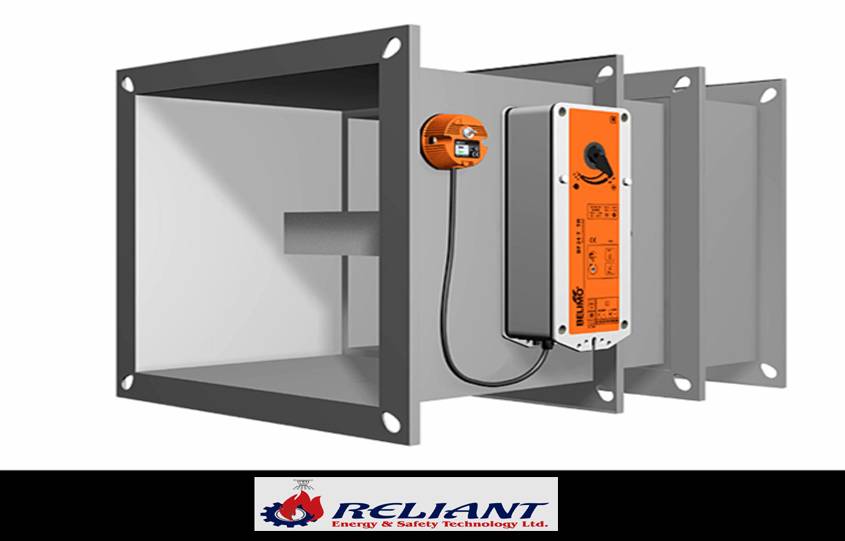The difference between smoke dampers vs. fire dampers is very important for building safety and fire control. During a fire situation, these simple but important parts are key to keeping people and property safe. Both are important parts of HVAC (Heating, Ventilation, and Air Conditioning) systems, but their functions and goals are very different, so it’s important to know the differences between them.
The passive fire defense system of a building is based on smoke dampers and fire dampers. They work with fire-rated walls and hurdles to make a strong barrier against the spread of smoke and fire. But at a key point, their jobs are very different: smoke dampers mostly control how smoke moves through a building, while fire dampers stop flames from spreading.
In this article, we look at the main differences between smoke dampers and fire dampers, including how they are made, how they work, and whether or not they meet building codes. By learning everything there is to know about these important parts, architects, engineers, and building managers can make better choices about how to install and maintain them. This keeps people safe and protects property in case of a fire. Join us as we explain how smoke dampers and fire dampers work and show how important they are for fire safety.
Smoke Dampers vs. Fire Dampers
The flow of smoke is controlled by smoke dampers, which keep smoke from spreading through HVAC systems. Fire dampers stop flames and heat from spreading, which keeps people safe from fire risks. Below The difference between the two is highlighted.
Smoke Dampers:
In the event of a fire, smoke dampers are an important part of a building’s fire protection system. They control the flow of smoke. These dampers are strategically put in HVAC (Heating, Ventilation, and Air Conditioning) ducts and openings in fire-rated walls and barriers. Their main job is to stop smoke from spreading, which can be just as dangerous as flames during a fire.
Most smoke dampers are made of fire-resistant materials and stay open during regular operation to let air flow through the ventilation system. But when a smoke detector or fire alarm system picks up on smoke, these dampers quickly close, stopping smoke from getting into other parts of the house. This important step helps keep people’s escape routes clear, makes it easier for firefighters to see what they are doing, and keeps smoke damage to property to a minimum.
To make sure that smoke dampers will work in case of a fire, you must follow local building rules and keep them in good shape. The importance of these dampers in fire safety systems is shown by the fact that they save lives and reduce the damage caused by smoke.
Fire Dampers:
On the other hand, fire dampers protect against fire in a wider range of ways. These devices are put in pipes and holes in fire-rated barriers. They are made to stop both smoke and flames from getting through. During normal HVAC function, fire dampers stay open, letting air flow through the building. But when these dampers are exposed to high temperatures, like those caused by a fire, they automatically close. This makes a barrier that stops the fire and smoke from spreading.
In contrast to smoke dampers, fire dampers are put through a lot of tests to make sure they can handle high temperatures and keep their shape during a fire. Because of this, fire dampers are an important part of separating rooms in a building and lowering the chance that a fire will spread.
Key Differences:
1. Function: The most important difference between smoke dampers and fire dampers is how they work. Smoke dampers are made to stop smoke from getting out, while fire dampers stop both smoke and flames.
2.Testing Standards: Because fire dampers help keep fires from spreading, they have to go through stricter tests. They are made to work well during a fire by being able to handle high heat and structural stress.
3.Installation Locations: Smoke dampers are usually put in ducts that go through fire-rated barriers. Fire dampers, on the other hand, are put in ducts, walls, floors, and ceilings that could help a fire spread.
4. Effect on Occupants: Both types of dampers help keep people safe, but smoke dampers mostly deal with air quality issues by keeping people from breathing in smoke. Since fire dampers can also put out flames, they add an extra layer of safety.
Conclusion:
It’s important to know the difference between smoke dampers and fire dampers when it comes to fire safety and building planning. Even though these parts are similar in idea, they are used in different ways to protect people and property from the effects of fires. By putting both smoke dampers and fire dampers into a building’s design and management plan, architects, engineers, and building owners can make the building safer and follow important fire safety rules.

